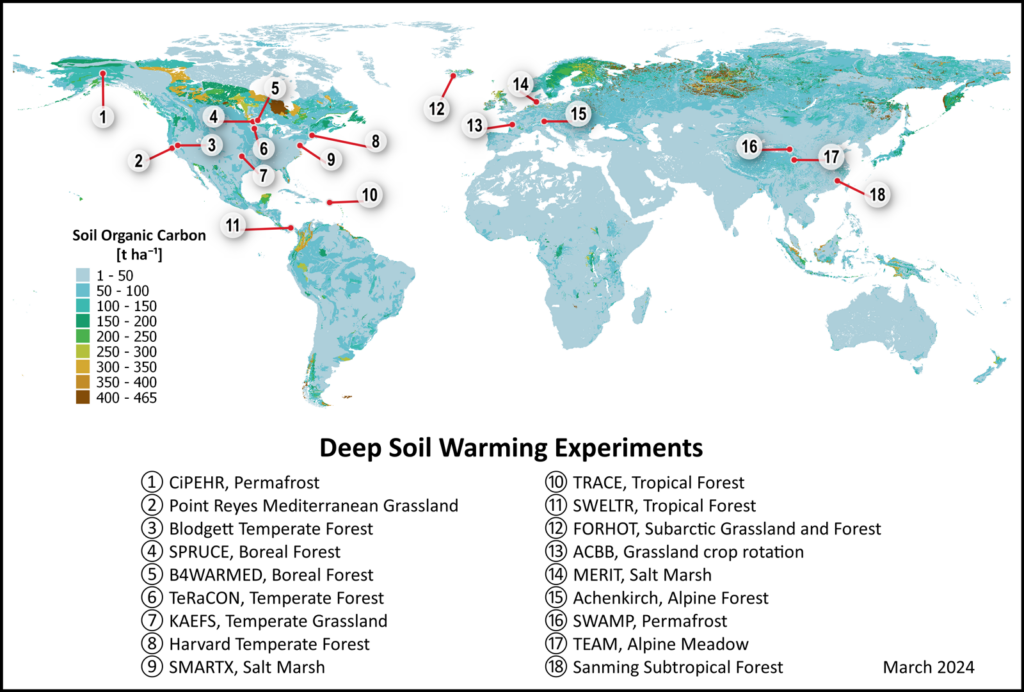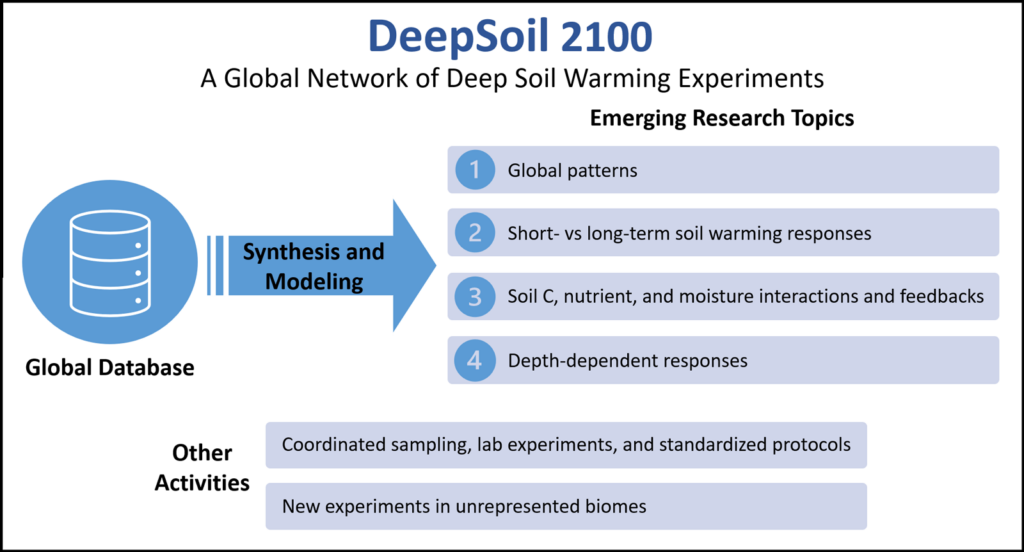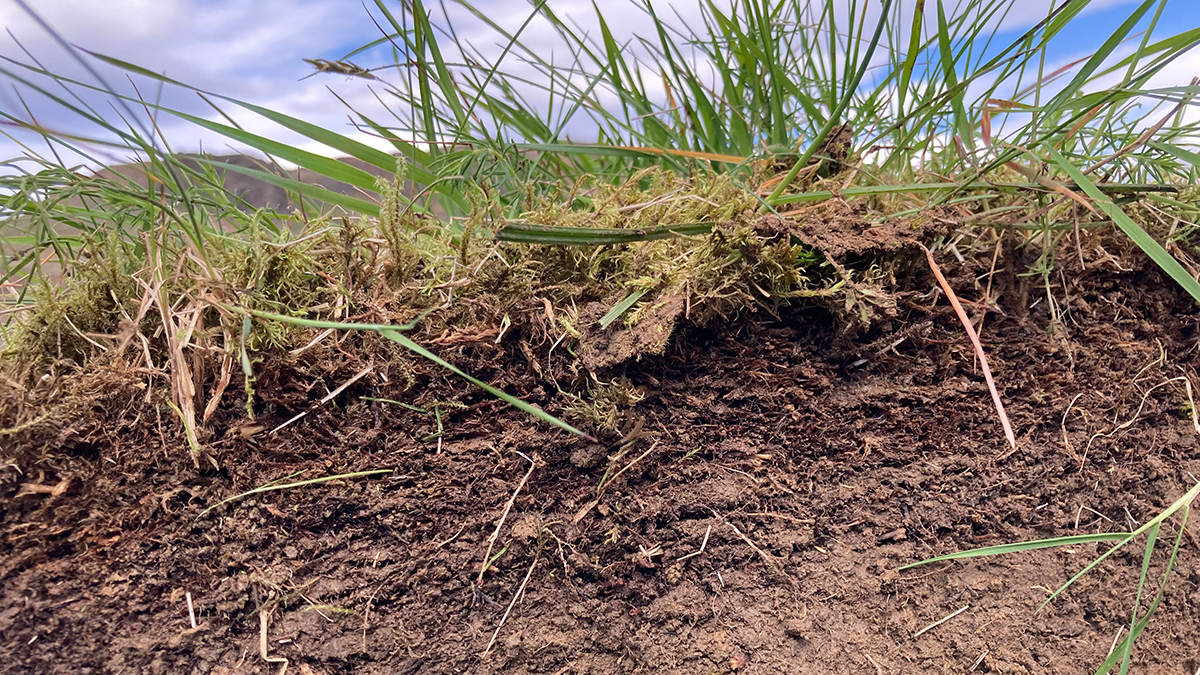Soil ecosystems play fundamental roles in sustaining food and fiber production, improving water quality and availability, sequestering carbon, and providing other societal needs. Climate warming affects the ability of soils to provide these ecosystem services, likely posing broad consequences for food security and the stability of ecosystems belowground and aboveground. To predict and manage these consequences effectively, it is crucial to understand how soil processes respond to rising temperatures.
Scientists worldwide have been conducting deep-soil-warming experiments, in which soil layers are deliberately heated to observe how plants, soils, and microbes respond. Recently, though, researchers have recognized the importance of comparing and integrating findings from these experiments to help reveal new insights.
The global DeepSoil 2100 network emerged from conversations among soil scientists convened in 2020 by one of us (M.W.I.S.) in response to this need for coordination. The network links field and lab researchers, modelers, data providers, and data users, and it provides a platform for sharing practical guidance for running field experiments, reporting data, discussing results, and exploring data synergies. Its goals include synthesizing results from soil-warming experiments, making these findings more accessible to a broader scientific community, and, ultimately, facilitating more informed predictions and decisionmaking regarding climate change and strategies for mitigation and adaptation.
Early efforts of the DeepSoil 2100 network involved bringing the research community together to share knowledge and expertise and to set the stage for future research and synthesis. In March 2023, more than 50 researchers from over 10 countries gathered for a workshop held at Sorbonne University in Paris, and a follow-up meeting took place in April 2023 during the European Geosciences Union General Assembly in Vienna, Austria. Discussions at these meetings centered around emerging areas for synthesis, the goal of learning from diverse experiments, and questions in need of collaborative investigation.
The Need for a Deeper Understanding
Soils undergo multiple interacting changes as temperatures increase.
Soils undergo multiple interacting changes as temperatures increase. Soil microorganisms generally become more active, accelerating the decomposition of soil organic matter and, in turn, the release of carbon dioxide (CO2) into the atmosphere. These changes affect many related soil functions and may reinforce climate change. That is, more CO2 in the atmosphere drives more greenhouse warming, causing soils to release even more CO2.
On the other hand, elevated temperatures can enhance plant uptake of carbon from the atmosphere by increasing photosynthesis, which could help to compensate for warming-induced soil carbon losses. Also, higher temperatures can significantly affect soil moisture and nutrient cycling, which can positively or negatively influence plant growth and soil processes.
Model predictions of terrestrial ecosystems’ responses to climate change, which result from our understanding of changing soil processes and the balance between soil carbon lost and gained, unfortunately, contain significant uncertainties, especially on a global scale [Bradford et al., 2016]. For instance, the land components in Earth system models do not represent microbes explicitly, do not resolve most of the mechanisms controlling soil organic matter decomposition rates, and have poorly defined parameters for many ecosystems and processes.
In addition, current model projections often rely on experimental data gathered mostly from the top 10 centimeters of soil profiles [Yost and Hartemink, 2020]. These studies provide insight into how warming affects near-surface soil layers, but they do not capture the complex interactions and feedback mechanisms occurring in deeper soil layers.
These novel experiments rely on buried cables, infrared heaters, and even natural geothermal heating to warm soils across a wide range of biomes.
Deep soils contain more than half of the global soil organic carbon stock [Rumpel and Kögel-Knabner, 2011; Jackson et al., 2017]. These deeper layers are warming as rapidly as near-surface soil layers [Soong et al., 2020], but they have received less attention. In recent years, however, several independent research teams around the world have established deep-soil-warming experiments (Figure 1), typically heating soil deeper than 30 centimeters below the surface to investigate plant and soil biogeochemistry responses. This approach provides a better representation of the whole complex soil system by considering all soil layers.
These novel experiments rely on buried cables, infrared heaters, and even natural geothermal heating to warm soils across a wide range of biomes [Hanson et al., 2017; O’Gorman et al., 2014], from forests in temperate and tropical areas to tundra, peatlands, temperate salt marshes, and subarctic grasslands (Figure 1). The efforts are providing new insights into the responses of soil carbon, nutrient cycling, vegetation, and soil microbes to warming throughout the entire soil profile. For example, recent studies have reported higher soil carbon loss under warming in deeper layers than in near-surface soils in temperate and subtropical forests [Soong et al., 2021; Lin et al., 2018].

When synthesized, data from these experiments will provide the foundation for a deeper and more holistic understanding of complex atmosphere-land interactions, thereby enhancing the accuracy of predictions of how terrestrial ecosystems under different management will react to climate change.
A Global Database and Emerging Areas for Synthesis
One of DeepSoil 2100’s first deliverables will be a database populated with observations from the deep-soil-warming experiments shown in Figure 1 and as many others as possible. These observations include warming-induced shifts in soil carbon stocks, soil respiration, root biomass, soil microbial community composition, and many other components of the soil ecosystem. Attendees at the meetings in 2023 discussed priorities for the database, which will feature a streamlined data entry pipeline, an adaptable and clear data structure, and an accessible interface for users to retrieve data easily.
Priorities for the database also include open accessibility and interoperability with existing soil carbon databases. To optimize interoperability, we are following data models and templates from recent successful databases, such as the International Soil Radiocarbon Database (ISRAD), the Soils Data Harmonization database (SoDaH), and the International Soil Carbon Network (ISCN) database [e.g., Malhotra et al., 2019].
We can evaluate whether ecosystem processes are acclimating to higher temperatures and compare short- versus long-term soil-warming responses.
Since the meetings, a preliminary database has been created with details about current deep-soil-warming experiments, including their locations, warming approaches, durations, and depths (including distance from the surface, soil horizons, and rooting density), as well as environmental parameters such as climate, soils, and vegetation. The next step will involve requesting original data from these experiments once a data-sharing agreement is in place.
Meeting attendees also discussed how the new database will facilitate synthesis studies and meta-analyses, model-data comparisons, the merging of model projections with data to refine predictions, and hypothesis testing using the full array of available deep-soil-warming data (Figure 2). The wide range of ecosystems covered by the experimental data in the database will allow scientists to assess global patterns and drivers of soil-warming responses while identifying key differences and similarities among sites. Furthermore, given the durations of current deep-soil-warming experiments—more than half have been running for more than a decade—we can evaluate whether ecosystem processes are acclimating to higher temperatures and compare short- versus long-term soil-warming responses [e.g., Melillo et al., 2017; Walker et al., 2020].

Synthesis studies could focus on how the response of soil carbon cycling within and among sites depends on soil nutrients and soil moisture dynamics. Rising temperatures can reduce soil moisture and alter nutrient availability, both of which can change the behavior of key carbon cycling components (e.g., plants and microbes) under prolonged warming. Seasonal and interannual variability in soil moisture and nutrients could be another mechanism to consider. For example, soil respiration and gross primary productivity (the rate at which plants capture solar energy during photosynthesis) are anticipated to be most sensitive to warming during seasonal transitions from dry to wet conditions, likely driven by an increase in nitrogen availability.
Synthesizing global data on deep soils will also be valuable for gaining insights into the dynamics and responses to warming of soil organisms responsible for carbon and nutrient cycling, plant and soil stoichiometry (the relative balance of nutrients and other elements present), and aboveground and belowground carbon inputs. All of these factors combine to influence the stability and composition of soil ecosystems, as well as soil fertility for plants.
Other synthesis studies may examine depth-explicit responses to warming, including changes in soil CO2 production and soil organic carbon stocks, as well as variations in the chemical components of soil organic matter and the age distribution of soil carbon through the soil profile. Distinct soil-warming responses with depth are expected to be driven by factors like soil moisture, root density, soil fauna activity, and interactions between soil organic matter and soil minerals.
Exploring processes in rooting zones compared with those in bulk soils across experimental sites is another rich area for collaborative exploration through DeepSoil 2100. Soil substrates and nutrient availabilities differ along soil profiles, and changes in belowground inputs of materials like root exudates (compounds released from living root cells) mediate many microbial and soil processes, potentially influencing long-term warming responses across depths. Coordinated field experiments using isotope labeling could complement such studies, for example, to examine how specific carbon and nutrient pools change with warming. Furthermore, controlled-temperature laboratory incubation experiments may be useful to elucidate the processes responsible for the warming-induced changes observed during field observations.
Calling for Interdisciplinary Deep-Soil Studies and Data
Gaining a deeper understanding of the effects of climate and climate change on belowground biogeochemistry requires comprehensive interdisciplinary studies.
Gaining a deeper understanding of the effects of climate and climate change on belowground biogeochemistry requires comprehensive interdisciplinary studies involving coordinated sampling at different experimental sites and across soil depths. Participants in the DeepSoil 2100 network pursue research in a range of biomes, but several ecosystem types and geographic regions lack representation, such as dryland ecosystems and ecosystems in Africa, Oceania, and the Southern Hemisphere broadly (Figure 1).
As a network, we encourage the establishment of new deep-soil-warming experiments, especially in these unrepresented areas, and we provide expertise and support to researchers planning such experiments by connecting them with scientists involved in established efforts. We also enthusiastically welcome representatives of current experimental efforts not already linked to DeepSoil 2100 to join the network.
Interdisciplinary global collaboration among experimentalists, data scientists, and modelers is indispensable. Through such collaboration, we can pursue comprehensive research, develop standardized protocols for field and lab experiments, and achieve major advances in building accurate models to gain insights into whole-soil dynamics and how they are changing as the ground warms. Only with these insights can we adequately adapt ecosystem management in the future.
Challenges to the future database and synthesis studies may arise because of differences in data structures and methodologies used across experimental sites, but the open dialogue and shared learning facilitated through the DeepSoil 2100 network provide opportunities to overcome these obstacles. By consolidating data from multiple experiments into a single standardized database, DeepSoil 2100 is promoting data sharing worldwide and facilitating more informed decisionmaking to address the profound impacts of global warming on soil processes and, by extension, on ecosystems and society.
Acknowledgments
We thank the in-person and online participants of the DeepSoil 2100 workshop held in Paris in 2023 for their contributions to emerging synthesis topics and the Observatoire des Sciences de l’Univers Ecce Terra for funding. We owe special thanks to Abad Chabbi and Samuel Abiven for their help with organization and scientific steering of the workshop and Jeffrey Beem-Miller for the update on the database status. F.P.S. acknowledges support from the FutureArctic project, funded by the European Union’s Horizon 2020 research and innovation program under the Marie Skłodowska-Curie Actions (grant 813114). A.M. acknowledges support from the Swiss National Science Foundation (project 200021_215214) and the Laboratory Directed Research and Development Program at Pacific Northwest National Laboratory under U.S. Department of Energy (DOE) contract DE-AC05-76RL01830. M.S.T. acknowledges support from the Office of Science, U.S. DOE, under contract DE-AC02-05CH11231. C.R. acknowledges the French Agence Nationale de la Recherche (ANR) for funding under the Soilwarm project (ANR-21-CE01-0025). M.W.I.S. acknowledges the Swiss National Science Foundation–funded DEEP C project (200021_172744).
References
Bradford, M. A., et al. (2016), Managing uncertainty in soil carbon feedbacks to climate change, Nat. Clim. Change, 6(8), 751–758, https://doi.org/10.1038/nclimate3071.
Hanson, P. J., et al. (2017), Attaining whole-ecosystem warming using air and deep-soil heating methods with an elevated CO2 atmosphere, Biogeosciences, 14(4), 861–883, https://doi.org/10.5194/bg-14-861-2017.
Hiederer, R., and M. Köchy (2012), Global Soil Organic Carbon Estimates and the Harmonized World Soil Database, Inst. for Environ. and Sustainability, Ispra, Italy, https://doi.org/10.2788/13267.
Jackson, R. B., et al. (2017), The ecology of soil carbon: Pools, vulnerabilities, and biotic and abiotic controls, Annu. Rev. Ecol. Evol. Syst., 48, 419–445, https://doi.org/10.1146/annurev-ecolsys-112414-054234.
Lin, W., et al. (2018), Warming exerts greater impacts on subsoil than topsoil CO2 efflux in a subtropical forest, Agric. For. Meteorol., 263, 137–146, https://doi.org/10.1016/j.agrformet.2018.08.014.
Malhotra, A., et al. (2019), The landscape of soil carbon data: Emerging questions, synergies and databases, Prog. Phys. Geogr., 43(5), 707–719, https://doi.org/10.1177/0309133319873309.
Melillo, J. M., et al. (2017), Long-term pattern and magnitude of soil carbon feedback to the climate system in a warming world, Science, 358(6359), 101–105, https://doi.org/10.1126/science.aan2874.
O’Gorman, E. J., et al. (2014), Climate change and geothermal ecosystems: Natural laboratories, sentinel systems, and future refugia, Global Change Biol., 20(11), 3,291–3,299, https://doi.org/10.1111/gcb.12602.
Rumpel, C., and I. Kögel-Knabner (2011), Deep soil organic matter—A key but poorly understood component of terrestrial C cycle, Plant Soil, 338(1), 143–158, https://doi.org/10.1007/s11104-010-0391-5.
Soong, J. L., et al. (2020), CMIP5 models predict rapid and deep soil warming over the 21st century, J. Geophys. Res. Biogeosci., 125(2), e2019JG005266, https://doi.org/10.1029/2019JG005266.
Soong, J. L., et al. (2021), Five years of whole-soil warming led to loss of subsoil carbon stocks and increased CO2 efflux, Sci. Adv., 7(21), eabd1343, https://doi.org/10.1126/sciadv.abd1343.
Walker, T. W. N., et al. (2020), A systemic overreaction to years versus decades of warming in a subarctic grassland ecosystem, Nat. Ecol. Evol., 4(1), 101–108, https://doi.org/10.1038/s41559-019-1055-3.
Yost, J. L., and A. E. Hartemink (2020), How deep is the soil studied—An analysis of four soil science journals, Plant Soil, 452(1–2), 5–18, https://doi.org/10.1007/s11104-020-04550-z.
Author Information
Fabrizzio Protti Sánchez ([email protected]), Department of Ecology, University of Innsbruck, Innsbruck, Austria; Avni Malhotra, Department of Geography, University of Zurich, Zurich, Switzerland; also at Biological Sciences Division, Pacific Northwest National Laboratory, Richland, Wash.; Michael W. I. Schmidt, Department of Geography, University of Zurich, Zurich, Switzerland; Cornelia Rumpel, Institute of Ecology and Environmental Sciences, Centre National de la Recherche Scientifique, Sorbonne Université, Paris, France; and Margaret S. Torn, Climate and Ecosystem Sciences Division, Lawrence Berkeley National Laboratory, Berkeley, Calif.

